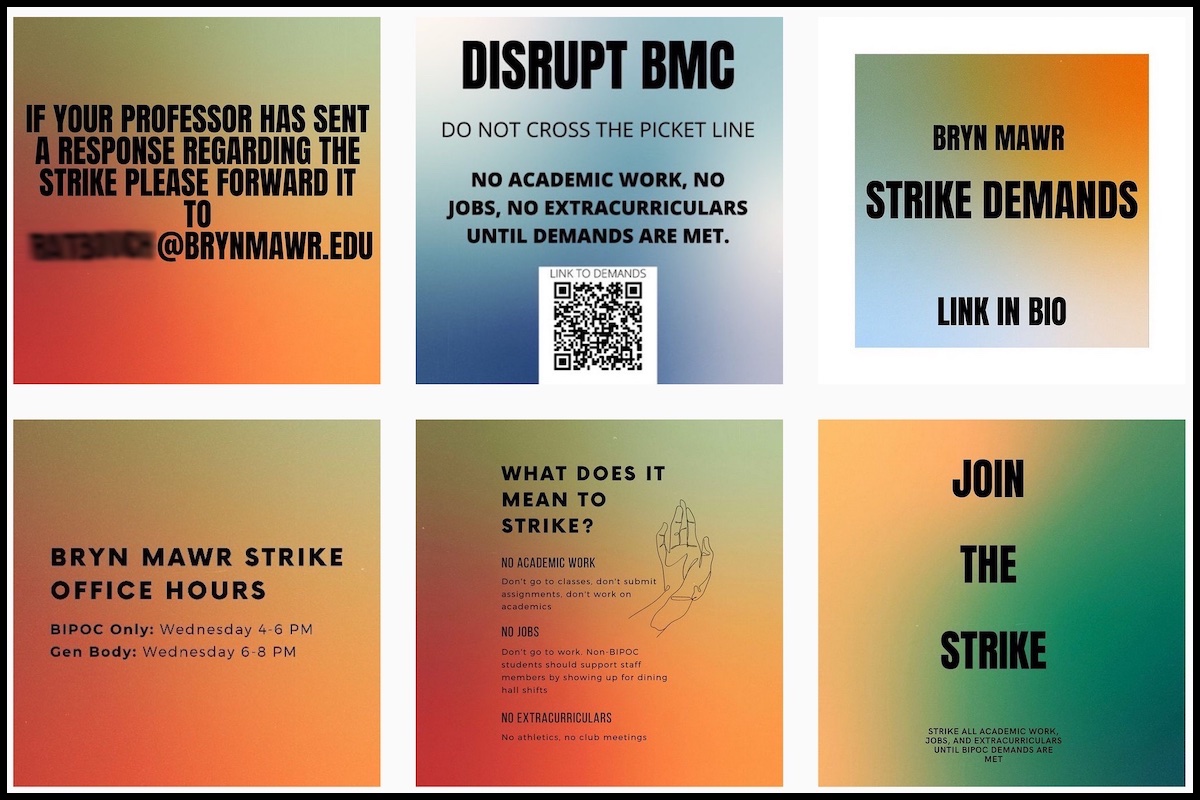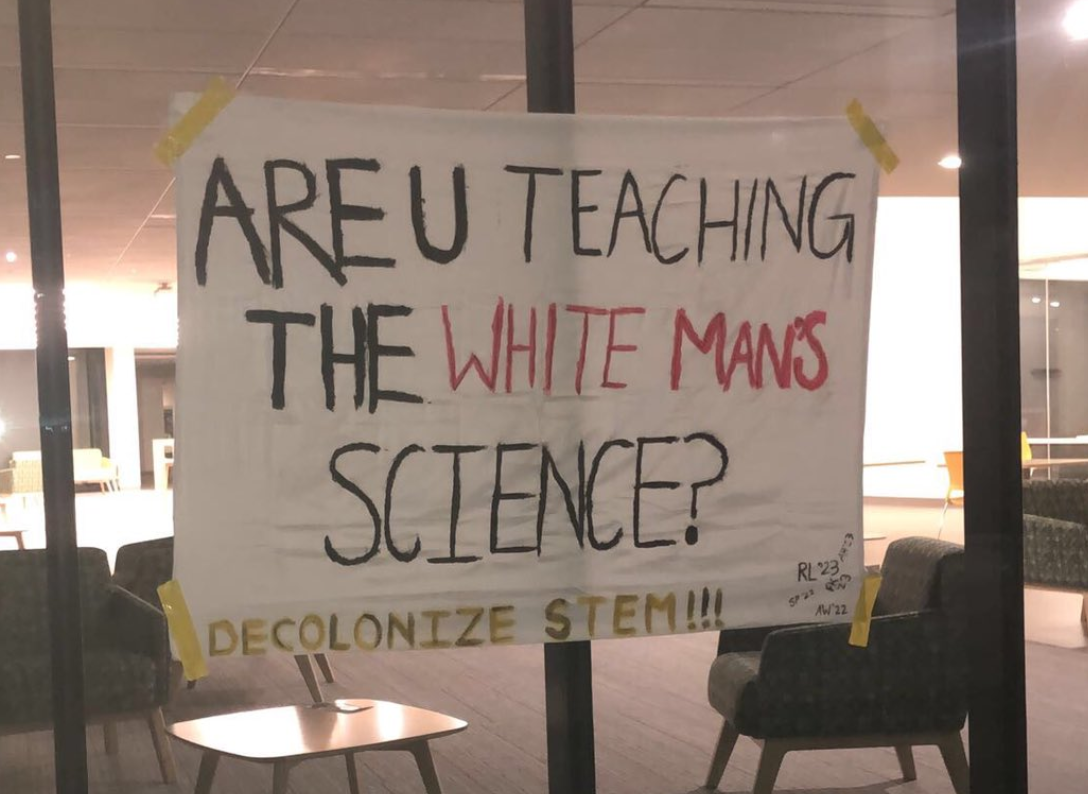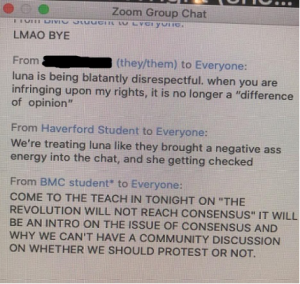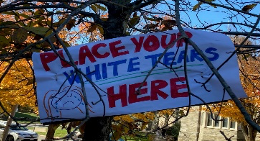Activism
A Student Mob Took Over Bryn Mawr. The College Said Thank You
Anyone who sought to attend class, go to the dining hall, or even turn in schoolwork was denounced as a “scab,” and often faced acts of bullying.

Ideology is a specious way of relating to the world. It offers human beings the illusion of an identity, of dignity, and of morality, while making it easier for them to part with them.
~Vaclav Havel
Last week marked the end of a chaotic semester at Bryn Mawr College, a small women’s liberal arts college located outside Philadelphia. During the final weeks, Bryn Mawr students, including my own child, scrambled to pick up the pieces following a student “strike” that exacerbated the serious preexisting disruptions associated with the COVID-19 pandemic. For a period of three weeks, few regular classes were held, activities were suspended, and student life (such as it was) became marked by the same toxic spirit of racism that the strikers claimed to oppose.
Bryn Mawr is affiliated with nearby Haverford College, whose parallel meltdown in November was documented recently by Quillette. These two selective and well-funded schools are part of a so-called Bi-Co arrangement, which allows students to participate in joint classes and activities. Both share a similarly progressive commitment to such causes as diversity, equity, and inclusion. And students at both schools generally are well-steeped in doctrines of intersectionality, “white fragility,” anti-racism, and all the rest. Yet following the police shooting of Walter Wallace Jr. in Philadelphia, activists at Haverford and Bryn Mawr embraced the dubious claim that their extremely progressive campuses were actually contaminated by a dangerous climate of racism that (quite literally) threatened the survival of black students. In many cases, the ire was directed not only at administrators and non-ideologically-compliant faculty, but also at any student suspected of not supporting the strikers’ apocalyptic rhetoric, dramatic postures, and inflated demands. Anyone who sought to attend class, go to the dining hall, or even turn in schoolwork was denounced as a “scab,” and often faced acts of bullying.
As the parent of a Bryn Mawr student (and the parent of a Bryn Mawr alumna), I found this profoundly unsettling. I kept expecting that, at some point, the administration would take decisive steps to restore order on campus (where, as at Haverford, in-person learning was supposed to be occurring, under COVID-19 testing and social-distancing protocols). But that never happened. Instead, a small group of largely unidentified students effectively shut down the campus—not because their views attracted majority support (only about a quarter of the student body seemed to really be on board, from what I could tell), but because the administration simply never pushed back.
I am not naïve about the ideological climate on campuses, having read about similar meltdowns at institutions such as Evergreen State College in Washington. But now it was happening at my daughter’s school. And the same electronic videoconferencing tools that allowed remote students to participate in college life gave me a front-row seat on the disintegration of Bryn Mawr’s civil society. I saw strike organizers publicly mocking and berating white students based on their skin color, followed by cringeworthy scenes of university officials desperately seeking to appease those same organizers.

This is a feminist women’s college, where one might think that administrators would be educated about the need to reject coercion, intimidation, and brute force as negotiating tactics. Yet here they were, apologizing to their tormentors. Having been married to an abusive husband, I’m sadly familiar with the temptation to justify one’s own abuse by insisting that the problem “must be me.” I never thought I’d see that same attitude exhibited by the women charged with educating my daughter.
The Bryn Mawr student strike, which formally began on October 28th, was led by something called the Bryn Mawr Strike Collective (BMSC), whose grandiosely stated goal was “to dismantle systemic oppression in the Bryn Mawr community,” and end the apparently crippling regime of “institutional racism, silencing, and instances of white supremacy.” Its list of demands was voluminous, and included a new required course on “Blackness and White Privilege,” additional funding for the campus Black Cultural Center, a call for a halt to the college’s (unspecified) acts of “violence against disabled students,” acknowledgement of “the unseen labor of Black women and Black trans/nonbinary people on campus,” as well as grade protection and money for the “work” that strikers were claiming to do to fight racism.

On November 6th, a week later, Bryn Mawr President Kim Cassidy responded with a proposed timeline for consideration and compliance. Like Wendy Raymond, her presidential counterpart at Haverford—another school founded by Quakers, and which at least nominally retains the Quaker commitment to consensual deliberation—Cassidy believed that the strike might be constructively addressed through town-hall discussions conducted in a climate of mutual respect. But strike organizers said they were offended by the offer to talk, claiming they hadn’t been given enough time to prepare, and refused to attend. Instead, they focused on organizing a sit-in that was streamed via Zoom.
Two days later, President Cassidy attempted to remind everyone that real educational credentials were on the line. (During this brief period, she demonstrated a modicum of courage.) Her statement called for students to return to classes on Monday, November 9th:
Education is our mission and our reason to exist. The College made a legal and moral contract with its students, and their families, to offer classes. We have an obligation to honor this contract. In doing so, we also recognize the significant financial sacrifices that students and families make for this education. When we do not offer opportunities for classes, it creates substantial dangers (or risks) for some, including international students whose student visas require that they attend classes and U.S. students receiving Federal- and State-funded grants and loans. Students cannot receive government financial aid (e.g. Pell Grants, many loans) unless we are accredited, and our accreditation by the Middle States Commission requires that we actively offer classes and a coherent learning experience toward a degree. Many students—even while indicating support for the goals of the strike—are expressing that they need to return to classes. In light of these serious consequences, and without wavering from our commitments to continue addressing the [strike] demands, the teaching of classes will resume on Monday in cases where classes have not been ongoing.
Following on numerous reports of abusive behaviour targeting students seeking to return to class, moreover, President Cassidy sent another email (for which, incredibly, she later apologized—but I’m getting ahead of myself) calling for a halt to these tactics:
Whatever the important goals of the strike and the demands, the College cannot countenance shaming, harassment, and intimidation of students or faculty to achieve them. The College cannot and will not tolerate a climate of fear where, amongst other examples, students are afraid to eat in the dining halls for fear of humiliation or for being seen as racist. The acts of intimidation that I am witnessing and that many students and faculty have described violate the [school’s] core principles. Students have a right to their education and should not have to endure shaming to attend class. Faculty have a contractual obligation to offer their classes and to provide students the curriculum that was promised. It is unacceptable for faculty to be targeted for public ridicule for doing so.
This proved to be the high-water mark for Cassidy. Regardless of her directives, many professors still refused to offer regular classes—some out of real solidarity with the strike organizers, while others simply wanted to avoid being targeted. And some of the professors who did hold classes taught only strike-approved content, i.e., discussions about racism and white supremacy. The strike “teach-ins,” meanwhile, typically consisted of videos with titles such as Histories of Queer Solidarity Against White Supremacy. The strikers, who urged that these materials be accorded academic credit, took careful note of who was consuming this or that media, so as to gauge which students and professors were supporting the strike and which weren’t.
School officials who interacted with students—such as Dean Jennifer Walters, who was pressured into speaking at a November 9th sit-in event when strike organizers spotted her walking her dog—were crudely mocked. By this time, it had become clear that what the strikers wanted wasn’t actual dialogue, but a series of melodramatic vignettes that showcased their claim to moral leadership. This included a November 13th town-hall meeting where they controlled the agenda, while attending anonymously so as to protect their identities.
Attendees learned that the strikers’ list of demands was now 23 pages long—up from the original five. Indeed, it took the organizers an hour just to read them out. They’d also upsized their original demands (quadrupling the price tag for the aforementioned cultural center, for instance). It was clear that the cost of all this would be picked up by parents. As at Haverford, administrators had by this time stopped even pretending to offer principled resistance, and were now focused on protecting their careers.
By the end of the meeting, Cassidy, along with Provost Tim Harte and Dean Walters, had agreed they would step down if the demands hadn’t been met to the strikers’ satisfaction. In what perhaps stands out as her most craven act, Cassidy also agreed to issue an apology for her (above-quoted) email decrying intimidation and bullying on campus—on the absurd basis that “my words suggested that this is a problem on campus that originates with strike supporters. It was wrong to convey this message and perpetuate a harmful stereotype.”

As November wore on, the strikers’ militant communiqués took on an oddly bureaucratic aspect, with Cassidy’s detailed announcements regarding her intention to fulfill the strike demands eliciting an eye-glazing 14-page BMSC critique. In online meetings, students who expressed their frustrations with the strike were told they’d be kicked out of web forums if such behavior continued. The strikers told students that the BMSC, and the BMSC alone, represented the “consensus,” and instructed everyone to attend teach-in events where they would be lectured on “why we can’t have a community discussion on whether we should protest or not.” While the administration was pleading for dialogue, these students were insisting that any diversity in viewpoint was a mask for white supremacy.
On November 21st, parents received an email from Kim Cassidy indicating that the strike was over. Like her counterpart at Haverford, she sought to convince everyone that the ordeal had been a win-win—having forced the entire community to “face our history in new ways, to confront persistent institutional barriers to progress and commit to change.”
As for the strike collective, it issued yet another lengthy, pretentious manifesto, titled “On Normalcy.” (The authors actually called this self-congratulatory 15-pager a “treatise,” as if it were a historic document being nailed to the door of a Wittenberg church.) The strikers also unveiled an even grander new name for their organization, The Black Student Liberatory Coalition (BSLC), and invited students and faculty to “continue to disrupt the fucking order.” Cassidy, whose academic expertise usefully centers on developmental psychology among children, naturally praised “On Normalcy” as “a powerful reflection on their actions, the outcomes of that collective effort, and their ongoing commitment to the work of change,” and invited everyone in the college community to read it.
I have written this piece under a pseudonym, though my identity is known to Quillette’s editors, as I have no wish for my daughter (who, being like-minded, intends to transfer to another college) to suffer for my expressed opinions. Like her fellow students, she’s been left to navigate a strange new landscape, one in which everyone has been put on notice that the school is now controlled not by its nominal administrators, but by a self-appointed militant student clique.

Far from facing consequences for ruining the fall, 2020 semester, strikers have been lavishly praised by the school’s president and continually assured that their grades won’t be impacted. Some professors have even agreed to accept what they call “strike work”—conversations with friends and family about racism, diary entries, time spent watching anti-racism documentaries, and so forth—in lieu of actual course work, even in math and science programs. Additionally, the college has instituted a credit/no-credit policy that will allow all students to choose up to four courses this year that won’t factor into their GPA.
As for the majority of students who came to Bryn Mawr to actually receive an education that goes beyond anti-racist bromides, they’re out of luck. The same goes for parents who ante up $54,000 a year for tuition (and another $20,000 for room and board). Kim Cassidy now presides over what is essentially the world’s most expensive anti-racism YouTube training program. Putting aside the disgrace associated with her cowardice, not to mention the outright abdication of her educational mandate, this also happens to be a massive rip-off for families, many of whom are spending their life savings so that a child can attend this once-esteemed institution.

What these students have learned—at a Quaker-founded institution no less—is that might makes right, that discussion and debate are for racists, and that the middle-aged elites who run society’s most prestigious institutions will sell them out for their own public-relations convenience, all the while publicly thanking the social-justice shakedown artists who engineered their own humiliation, thus incentivizing more tantrums in the future.
“We’re all gonna be here for only four, maybe five years, so nobody really gives a damn about Bryn Mawr in the long run,” said one anonymous strike leader at a November 9th sit-in event. It’s an appalling sentiment. But unlike President Kim Cassidy’s groveling communiqués, it at least has the benefit of being honest.






